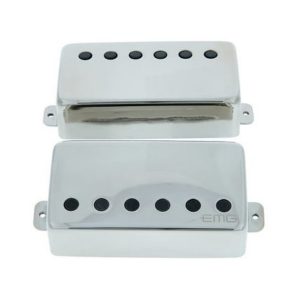
- Bridge System – Adjustable
- Rock, Hard Rock, Metal
- 6 Strings
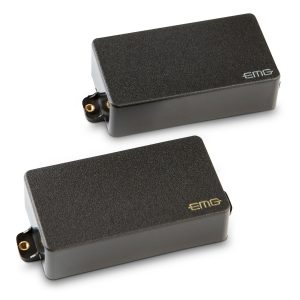
- Bridge System – Adjustable
- Rock, Hard Rock, Metal
- 6 Strings
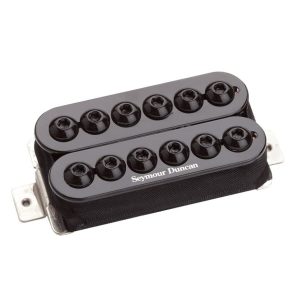
- 3 Large Ceramic Magnets
- Punk, Garage, Thrash, Metal
- 6 Strings

- Better For Bridge Position
- From Heavy Blues To Metal
- 6 Strings
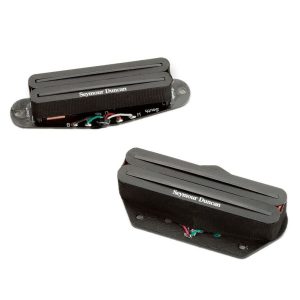
- Ceramic Magnet
- All Of Rock And Metal
- Output DCR – 16
Choose the Best Pickup for Metal
Customer’s Choice: the Best Rated Pickups for Metal
16 users answered this survey. Please help us improve this review!
A guitar pickup is a device that turns the mechanical vibration of a string into an electric signal. The current generated by this process is then sent to an amplifier, which increases the power of the signal so you can hear it through speakers or headphones. A pickup is basically a small microphone.
Features of pickups for metal music:
- Magnet type (ferrous or ferrite);
- Number of coils – single, dual, and triple coil pickups are common in metal music;
- Pickup coverings like soap bar cover to protect them from damage if they’re hit by the pick during playing. They also look great;
What are the best pickups for metal? This question plagues every metalhead. It’s all about personal preference, but that doesn’t mean you can’t get some advice! In this article, metal music experts will give you our suggestions on what pickups to try out depending on your budget and genre of music. Read on to find out more about some of the pickups for metal!
Table of Contents
EMG JH James Hetfield Signature Guitar Pickup Set – the Editor’s choice!
 The Hetfield Signature Floyd Rose Bridge provides a tight, punchy sound with less inductance in the coil for a brighter low-end. Unleash your inner Metallica at practice or on stage with original EMG James Hetfield Pickups that are soldered into place for easy installation.
The Hetfield Signature Floyd Rose Bridge provides a tight, punchy sound with less inductance in the coil for a brighter low-end. Unleash your inner Metallica at practice or on stage with original EMG James Hetfield Pickups that are soldered into place for easy installation.
Stealthily installed within the guitar’s electronics cavity, these pickups work great on both clean settings and distorted tones.
Compatible for any EMG guitar collection these pickups are active tone with clarity and punch of passive pickups.
The EMG James Hetfield Signature Guitar Pickup Set is the tone of choice for Metallica lead guitarist, James Hetfield. The bridge pickup has a tight attack with much less inductance for a cleaner low-end sound that’s well-suited to distortion without any added noise or feedback issues.
EMG ZW Zakk Wylde Signature Humbucker Guitar Pickup Set – the best for easy installation!
 Now you can have the raw sound of Zakk Wylde’s signature pickups in your own electric guitar! That is if you give up the idea that they’re anything but terrible. The installation instructions are excellent, it comes with both EMG 81 & 85 active pickups for a little extra versatility in tone.
Now you can have the raw sound of Zakk Wylde’s signature pickups in your own electric guitar! That is if you give up the idea that they’re anything but terrible. The installation instructions are excellent, it comes with both EMG 81 & 85 active pickups for a little extra versatility in tone.
It only takes a few minutes to install, and when you’re done there will be absolutely no soldering required–perfect for those who’ve never touched an electric guitar before.
All jokes aside, this pickup set has incredible power and sustain and works excellently on even single-coil guitars because of Zakk Wylde’s aggressive style of playing.
The EMG Zakk Wylde Signature Humbucker Guitar Pickup Set is the brainchild of rock icon, Pearl Jam guitarist and Black Label Society frontman, Zakk Wylde. Now you can achieve an aggressive tone with sustained power like never before, all thanks to the innovative pickup set! Whether it’s for your guitar or bass, these pickups are sure to find a home in any music enthusiast’s arsenal.
Seymour Duncan SH8 Invader Humbucker Bridge Pickup – the best for the aggressive sound!
 Seymour Duncan has been a leading manufacturer of guitar parts and equipment since the late ’50s.
Seymour Duncan has been a leading manufacturer of guitar parts and equipment since the late ’50s.
Discover Seymour’s newest pickup line with Seymour Duncan SH8 Invader Humbucker Bridge Pickup that includes an all-black design, three ceramic magnets, over-wound coils, four-conductor hookups offering complex configurations, the wide magnetic field for high output sound. A truly realistic and attractive price point.
Seymour Duncan SH8 Invader Humbucker Bridge Pickup delivers a real, aggressive sound thanks to the wide magnetic field and over-wound coils. Black, menacing design. Easy to fit in a standard humbucker route.
Seymour Duncan TB-4 JB Trembucker – the best for different music genres!
 Seymour Duncan’s TB-4 Trembucker is the world’s most popular humbucker. This pickup will suit your needs for any sort of heavy blues or heavy metal. It works especially well with rosewood fingerboards and does not produce an overly bright sound. The four-conductor hook-up cable allows you to tap into different settings if desired, making the Seymour Duncan JB trembucker great for all sorts of diverse musicians.
Seymour Duncan’s TB-4 Trembucker is the world’s most popular humbucker. This pickup will suit your needs for any sort of heavy blues or heavy metal. It works especially well with rosewood fingerboards and does not produce an overly bright sound. The four-conductor hook-up cable allows you to tap into different settings if desired, making the Seymour Duncan JB trembucker great for all sorts of diverse musicians.
This stacked humbucker sound is one of Seymour’s most popular designs – recommended for the bridge position and especially suited to those who rely on big melodies as well as some crunching rhythms.
Plug it in and you’ll be converted. Seymour Duncan’s TB-4 JB Trembucker delivers a thick, crunchy sound with balanced output for everything from heavy blues to heavy metal.
Seymour Duncan Hot Rails Tele Set – the best for Fender Telecaster!
 Seymour Duncan’s Seymour Duncan Hot Rails Tele Set brings a new level of sonic power output to your instrument. You’ll be able to finesse your sound from pure, clean tones for rhythm work to molten metal outbursts with just the turn of a knob!
Seymour Duncan’s Seymour Duncan Hot Rails Tele Set brings a new level of sonic power output to your instrument. You’ll be able to finesse your sound from pure, clean tones for rhythm work to molten metal outbursts with just the turn of a knob!
Lift your Telecaster to a new level with Seymour Duncan’s Hot Rails pickup set. In all honesty, you’re going to be blown away by the punch and power of this guitar upgrade thanks to its hot output and crunch. You’ll find it difficult not to stay plugged in after installing these divine electric components onto your Tele.
4-conductor wiring offers many versatile wiring options for making each sound totally unique – whether you want a vintage vibe on clean settings or a high-tech grind when rocking hard on distortion channels.
Kick your Tele into high gear with Seymour Duncan’s unique, dual-blade humbucker set. This pickup set features a special noise-canceling design and can be used as either single-coil (humbucking) or full humbucker (dual blades).
The Buyer’s Guide
Major types of guitar pickups:
- Neck pickups – generally sound warm, soft, and smooth. Good for clean rhythm playing or blues lead parts with lots of sustain;
- Bridge pickups – typically brighter than neck pickups, these are great for overdriven leads (think AC/DC) as well as screaming solos with a tight response. They work best when the tone is cool to neutral in character;
- Humbuckers – these provide tonal characteristics somewhere between single-coil guitars and more powerful humbuckers that feature and added coil that cancels noise caused by stray electromagnetic fields. This type of pickup can be found on both electric guitar types mentioned above, but they’re most common among semi-acoustic models such as Gibson Series;
Active vs. Passive Pickup
1) A passive pickup is a traditional guitar-style magnetic pickup. It has magnets on both the pole pieces and underneath the coil wire, which are wound around small ferromagnetic rods called ‘stainless steel’ poles to give it its name. This design creates more inductance in the signal path than an active or humbucking pickup because of their iron core construction.
They have less output level but usually sound clearer with increased mid-range detail when compared to active pickups. You can recognize them by checking that they don’t have any battery power supply wires coming from the body cavity – just two thin lead wires for each individual string.
Passive pickups are generally more expensive than active so if you’re on a tight budget, it might be worth considering an active pickup instead.
2) Active pickups have a preamp circuit built into the pickup housing that boosts and drives your signal. Active circuits do not use batteries, which is what makes them more expensive than passive ones.
Besides their increased output levels, they also sound thicker and warmer with less noise due to lower inductance in the coils of the pickups, which results from using fewer turns on each coil wire. They also tend to be better for drop tunings because you don’t need an abnormally long lead wire like you would with a passive design.
They also have a higher inductance that results in less treble and definition than the passive pickups. The high frequencies are not as good as those of an active pickup, even when you use trim pots to reduce it. The very low-end sound is somewhat different from that created by a passive design because they require more amplification before being sent through your effects pedals or amplifier input jack so they might take some time getting used to if you’re coming from using passives previously.
Active pickups can be recognized by seeing battery power leads connected directly to their casing (without any other components).
Passive pickups are the opposite of active ones, using no batteries and their case is not connected to anything else.
Active pickups require a battery to power them while passive ones don’t. They also typically produce more output than their un-powered counterparts do. The extra gain comes in handy when using high overdrive settings on an amplifier because it will maintain clarity even at higher volumes without getting lost amongst the distortion of the amp itself (which usually gets muddy).
Passive humbuckers generally have less “sag” meaning they sound tighter overall with stronger due to increased magnetic pull strength. Active pickups do have their downsides though, they can drain batteries if you forget to turn them off and the more power used usually means a brighter tone which isn’t always desirable.
Main Features:
- Tone
The first thing you need to know is that pickups are not created equal. Each type of pickup has its own unique tonal characteristics, so it’s important for your personal sound preferences and styles of music that you use the right types of guitar pickups on your instrument.
Many people think that electric guitar pickups are all the same, but they’re not right when it comes to sound quality. First, let’s talk about what makes a good pickup in general terms.
The good tone is rich and well-balanced. There isn’t too many high frequencies or low frequencies (bass). There should be some presence around middle C (261Hz) since this does affect clarity – however, you don’t want to boost anything lower than 100Hz or higher than 6000Hz either because it will make your instrument muddy sounding.
You’ll find that some pickups are also bright sounding, meaning that they have a lot of presence in the high frequencies. Other types will be warmer and mellower with less treble.
If you’re looking for more low-end power then humbucking pickups might be right up your alley because these tend to produce much stronger bass frequencies.
If you are looking for a more natural sound with less electrical interference then go for single-coil pickups. This is what Fender originally used to make their guitars that means they have been perfecting it over time!
The best way to determine which type is right for you is by playing as many different guitars with different pickup configurations as possible – this way you can hear exactly what each one sounds like before making up your mind about which ones sound good or bad. You may even find it useful to bring along someone who plays guitar so he/she can give you their opinion on how well they think the instrument sounds.
When doing this, remember not to listen too much to whether an individual note is played cleanly (i.e., without distortion) because every electric guitar has its unique distortion characteristics – distortion is actually part of how a guitar sounds, so it can’t really be removed from the equation.
- Versatility
One of the most important things to consider when you’re buying guitar pickups is how versatile they are. The best metal pickups need to be able to handle both clean and distorted tones, as well as different genres such as jazz or blues. There’s no point in choosing a high-output pickup if it can only sound good with extreme gain settings – that defeats the purpose!
A great choice for versatility would therefore be an active humbucker like those made by EMG (more on these later). Active pickups have their own preamp built into them that gives them more headroom than traditional passive units do. This means that even at low volume levels they offer a powerful, clear tone without losing any dynamics.
Another thing worth bearing in mind is that high-output humbuckers will often be brighter in character than single-coil pickups. They’ll also generally have a thicker, more substantial sound which works well for metal but may not suit other genres as well. For this reason, you might want to consider buying separate units instead of choosing one type exclusively if versatility is important to you.
- Budget
The budget should be a factor when choosing the right pickups for your guitar.
Active pickups tend to produce more output volume, but they also require batteries that need changing from time to time. Passive pickups don’t use batteries as much as active ones do; however, this type doesn’t provide as much gain as an active one does either because it is not powered via the battery itself.
The level of budget can also affect the tonal variety you get from your pickups. For example, if you are on a low budget, it is best to choose active ones since passive pickups tend to be more expensive. Also, consider that there are different types within each category (active or passive) which could cost even more depending on what type of sound quality and output volume they provide.
However, if you have higher budgets for guitar gear then one solution would be to buy an electric guitar with already installed premium pickups such as the Ibanez RG Premium line that comes with EMG 81/60 pickups in both bridge and neck positions respectively. These two offer superior tone and gain than many other brands at their price range; you could also opt for the Ibanez RG421 that comes with DiMarzio IBZ/USA pickups as stock equipment.
- Brand
Some of the most popular manufacturers of pickups for metal music are:
- EMG pickups are manufactured by the company, which has one of the biggest catalogs of guitars. They produce passive and active pickups with various styles (single coil, humbucker). Many metal artists use their products because they provide an aggressive sound for lead playing. The downside is that some players find them too “muddy”, but you might like it if you like death or heavy metal genres. You can choose between single coils (with increased treble) or more powerful double coils (more bass – older models have high output levels);
- Seymour Duncan. This brand offers very good quality items at a reasonable price range, so many beginners give up on these guitar parts before even having tried them out! Their products are suitable for various genres of music and the sound is very unique. They have a huge catalog with many different products, so you can choose between passive or active pickups (passive models give more powerful output levels);
- DiMarzio offers several types of guitar parts: single coils, double coils, humbuckers, etc., depending on your style preference. The pros include good quality materials used in production; cons could be high price range compared to other brands/models;
- Lace pickups provide an extremely clean sound that’s not too aggressive but it has enough “heaviness” to make metal songs come alive. Passive pickups (no batteries required) and suitable for rock, blues, and jazz genres. The cons include the high price range; some players find them too “bland” or even useless when it comes to metal;
Pickup Care and Maintenance:
- Avoid getting moisture in the chamber of your guitar pickup. Although you can’t avoid humidity, it is best to keep your pickups away from any direct source of water or excessive wetness that may cause rusting;
- Do not use solvents on your guitar’s surface when cleaning as they will dissolve the original coating and leave a sticky residue behind which attracts dirt particles leading to permanent damage. Use soap and warm water instead along with soft cloths for proper cleaning;
- Do not place your guitar in a dusty environment as this will also result in the same accumulation of dirt particles. Keep it safe and clean:
- Always remember that cleaning is an essential part of caring for your instrument so give it some attention every once in a while to keep it looking good and playing well;
- Try not to move your guitar around when it’s plugged in. This can lead to damage of the inside components if you are using a hollow body electric which is more susceptible to wear and tear because of its open chamber design;
- Be careful about leaning, bumping, or dropping your instrument as this may cause some internal issues that will be difficult to repair later on leading to expensive repairs;
- If something feels wrong about how your guitar sounds, check all connections before assuming there is an issue with the pickups themselves. Even though they take most of the blame, it doesn’t hurt to eliminate other factors first;
- When installed correctly, pickups should provide a snug fit that allows them to stay in place without being held;
- It’s ok if your new pickup does not have the same shade of color as your old one but it is important for there to be consistency within the brand or model you are using so check before installation;
FAQ
How do pickups affect tone?
Pickups function as magnets and create an alternating current of electricity. They do this by sensing the vibrations from metal strings, which is then transmitted to a guitar amplifier for sound output.
The type and number of pickups on a guitar will determine the tone, whether it’s twangy Fender sound or booming Gibson roar.
Since different types of wood have their unique resonant frequency, changing your pickups can dramatically alter how each string sounds.
Why are humbuckers good for metal?
Humbuckers have a thick, meaty tone with an accentuated low-end and the ability to handle higher gain. The reason they are so popular for metal is due to their ability to deliver high output while maintaining clarity when playing fast palm mutes or power chords in drop tuning.
Humbuckers also provide fatness that’s hard to achieve with single coils which can be useful if you want your guitar sound to stand out from the mix of other instruments on stage.
Humbucker pickups usually come in two varieties: neck and bridge. The neck pickup is mainly used for clean tones while the bridge delivers a bright, cutting sound that makes it very useful in metal riffs with high gain distortion.
Humbuckers are also very responsive to gains of distortion.
They provide more sustain than single coils, making them suitable for playing metal solos as well. The best way to get a tight low-end is by turning down the bass on your amp or using an equalizer pedal right before you enter into your effects chain which will give you full control over the tone and boost it where necessary. This will allow you to keep everything balanced at all times even if there’s some extra gain in one part of the song that needs attention.
Humbucker pickups can be quite noisy though so make sure not to turn up the volume too high when switching between riffs with different amounts of distortion because they are known for feeding back.
What pickups does James Hetfield use?
James Hetfield is the lead guitarist and vocalist of Metallica. He has used several guitars over his career, but most people cite one guitar in particular as his main instrument: a Gibson Les Paul Custom with EMG 81/60 pickups installed (he also uses other guitars). The reason why he prefers using these electric guitar pickups for metal? They give him that true metal sound that he requires to fulfill his musical needs.
Does James Hetfield use active pickups?
Metallica’s frontman James Hetfield has been known to use active pickups in most of his instruments over the years.
On Metallica’s debut album, Kill ‘Em All, he used a DiMarzio X-series humbucker from the Custom Shop on his guitar. This pickup is passive by nature but comes with an added preamp that gives it more power and sustains than traditional passive pickups. The Seymour Duncan SH-PGP was also one of Hetfield’s preferred pickups for many years before being replaced by EMG active electronics when they entered their “Load” era back in 1996.
Active or not, James Hetfield has always kept things simple within the realm of metal music: fewer effects are equal better tone in his opinion.
How can you make your amp sound like Metallica?
If you want to sound like Metallica, the first thing is not your amp. It might be tempting but they use large amounts of effects on their guitar tracks. So if you really care about sounding like them, focus more on finding guitars with humbuckers and a good distortion pedal.
Once you have that, look for a high-quality tube amp.
Some amps are already great with metal and some others might need to be tweaked but here is how each type of amp sounds like:
- Solid-state – does not sound very good on its own so it will never sound as good as a tube. However, if you use the right pedal, these can stack well with your distortion pedal or even by themselves (if they have enough power). This kind of amplification is usually used in smaller venues because it has less impact than tubes (see our guide about guitar cabinets);
- Tube – this one needs more tweaking and pedals before sounding really heavy but once done properly gives off rich harmonic overtones which makes them perfect for playing metal music;
- Hybrid – these are the ones most metal guitarists use. They sound really good when you plug them in and can also be tweaked to achieve distortion so it is a matter of preference;
If your budget allows, go for an all-tube amp head because they usually give off a better tone than their solid-state counterpart but if not, there are several high-quality hybrid amps that stack well with pedals without compromising too much on tone or volume (see our guide about tubes).
What pickups does Kirk Hammett use?
Hetfield’s fellow bandmate Kirk Hammett also uses two Seymour Duncan active pickups in his ESP KH-11 signature guitar, the Pearly Gates model. The Seymour Duncan JB Jr humbucker is used at the neck position while a hot rail single coil pickup provides an extra dose of crunch and output when needed.
Are humbuckers louder than single coils?
Not necessarily. The volume of an electric guitar is determined by the amount of power that’s being sent to its amplifier, not the pickup type – no matter if it is single-coil or humbucker. However, there are factors that influence how loud your signal will be at any given time: pick gauge, string action, and playing style.
Humbuckers are generally louder because of the way they’re wired. The same pickup that acts as a weak signal when played by itself will act as an even weaker one if it is combined with another one, so together they create a stronger sound that has less noise and more output power.
Keep in mind though that this isn’t always the case – there are high-quality passive humbuckers out there, just like their counterparts – single-coil pickups can also be made to produce very powerful sounds. It all comes down to your personal playing style! Make sure you find something that fits your needs best for maximum potential gain without any unnecessary headaches along the way.
Why is my neck pickup louder than the bridge?
This is caused by the pickup being closer to your body than it is to the bridge. As a rule, when you play in an open tuning (such as E-A-D-G), you will get more volume out of your neck pickup because there are fewer strings fighting for space.
Additionally, when you play in standard or drop D tuning (where there are only four strings), your bridge pickup will actually be louder than the neck. However, this is because the neck pickup will be producing less treble on your six-string guitar.
Which pickup is the lead pickup?
The lead pickup on a guitar is the first one that you play. It gets its name from being used to “lead” into a song or riff, as opposed to following it. The best way for beginners to identify their primary lead pickup is by playing a series of power chords and listening carefully to which note sounds more pronounced without touching your distortion pedal (or amp).
If the higher notes of your chords are sounding more pronounced, you can bet that it is one of your lead pickups.
This step ensures that you’re playing with the correct pickup first and also helps for identifying where to place which pickups in future steps.
What is impedance? How does it affect your sound?
Impedance refers to the resistance of an electric circuit including all components from input jack to speaker output. In other words, how much your signal “stalls” as it moves along every piece of equipment between guitar and amp (or effects pedal in line with your setup) will determine whether your tone sounds good/accurate or bad/muddy.
A higher amount of impedance found typically on passive pickups creates a tighter overall low-end response meaning bass frequencies aren’t lost when moving through multiple pieces of gear. This will make it easier to create a clean and accurate representation of your desired tone. As always, there are exceptions as some amps/pedals may sound better with less impedance (typically found on active pickups) but this depends solely on personal preference.
Useful Video: The Best Pickup for Rock/Metal?
Final thoughts
In conclusion, there are many pickups for metal out there and it’s hard to know where to start. Luckily, metal music experts have some suggestions if you want help finding the right pickup for your sound! Try out depending on your budget and the genre of music that you play. Whether it be vintage or modern, there is something here for everyone!


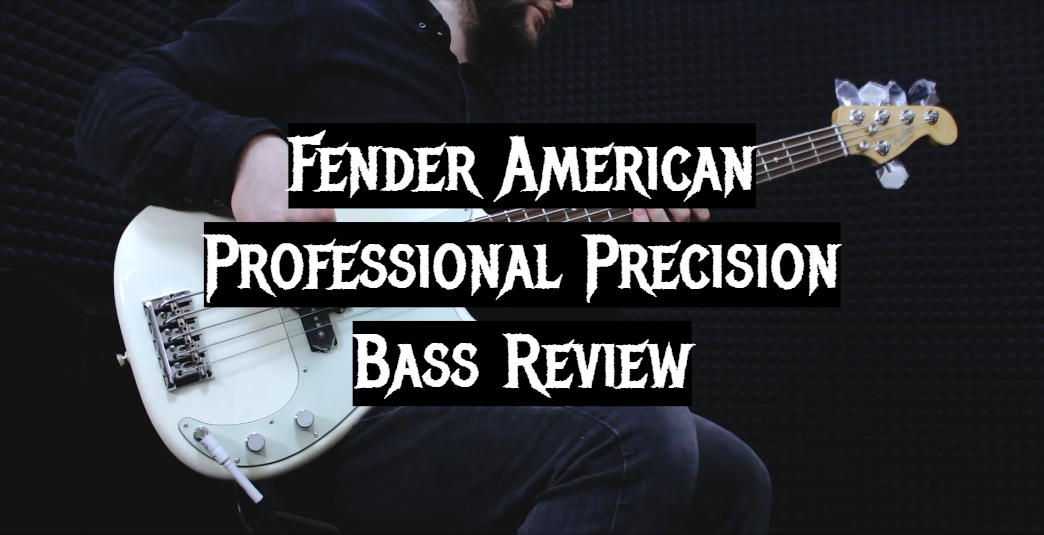

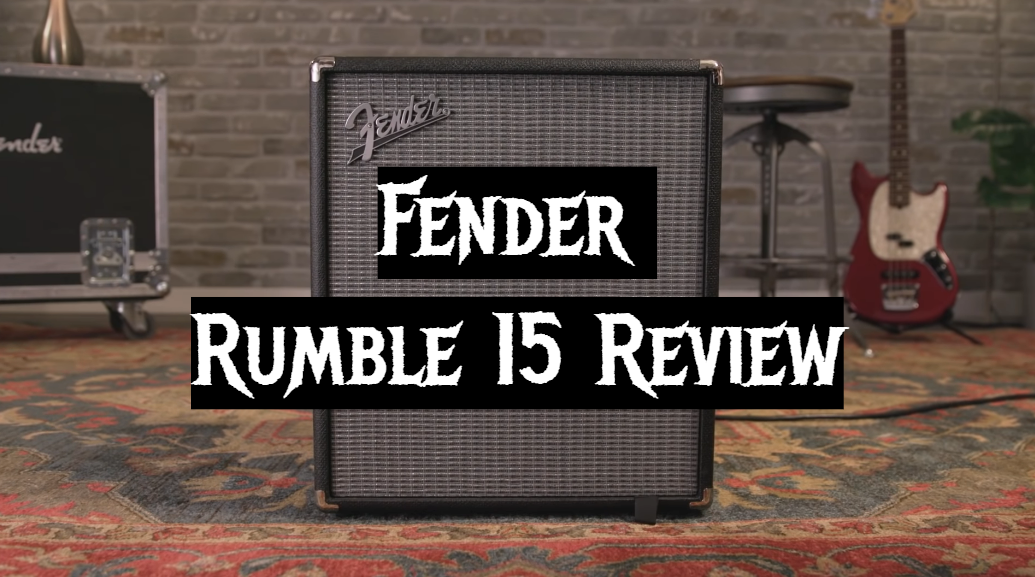
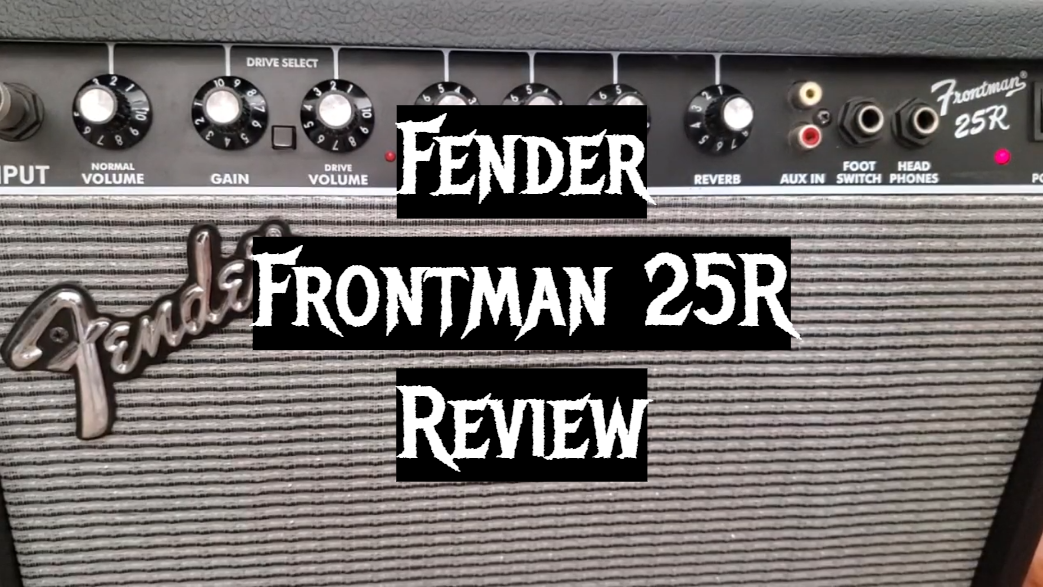
Leave a Reply